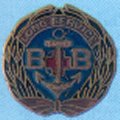
EFFICIENCY / SERVICE BADGES
| The Five Pointed or "White" Star | |
 |
Used as a Battalion Efficiency or Good Conduct Badge by some Battalions (never HQ issue) from c.1890 until the introduction of the One Year Efficiency Badge in 1904. Worn on right forearm.
|
| One Year Efficiency Badge 1904/1926 & One Year Service Badge 1926/1968 | |
 |
Introduced in 1904 as an efficiency badge taking over from the star. The wearing of this badge was optional and some battalions and their companies never awarded it. Some areas used it and referred to it as a "star", other areas called it a "pip". Its design was almost the same until it was discontinued in 1968, the only difference being the addition of the BLB cross behind the anchor in 1926 and its role changing to service. Its title now changed to "One Year Service Badge" it was awarded for Good conduct and not more than two absences during the Session. |
 |
| The Company Section / Brigade Service Badge | ||||||
 |
Post 1968 the service badges were reduced to just one silver barrel shaped badge with the numbers of years service in the Company Section inserted. This was changed in 1976 to include the total years service in the whole Company including Junior Section.
|
|||||
| The Three Year Anchor 1888-1926 | ||||||
 |
Introduced in 1888, there had been much discussion in earlier years re. the appropriate length of service required for such a badge. It was finally deemed that Boys who had served in the Brigade for three years or more with Good Conduct would be entitled to wear a silver anchor on the right arm when in uniform. For NCO’s it was placed in the "V" of the chevron. It could be worn at and after the Company Inspection – the traditional time for presentations – or at the close of the Third Year. The badge was originally designed by taking the centre anchor from the Officers Glengarry hat badge.
|
|||||
| The Three Year Service Badge 1927-1968 | ||||||
 |
With the union of the Boys’ Brigade and Boys’ Life Brigade in 1926 the attractive and delicate design of this badge took on a bolder style with the addition of a red cross of the Boys’ Life Brigade being placed behind the anchor. The two "B’s" then moved to the ends of the transverse arms of the cross. The design has not changed since that time. It has been used as a service badge with different fittings as a uniform badge and as the general crest of the Brigade. This badge as part of the award system was discontinued in 1968.
|
|||||
| The Long Service Badges | ||||||
 |
This badge was introduced in 1927. This was awarded not earlier than 31st December in Session in which they attained the age limit, after serving not less than four years’ service with good conduct. It was generally issued at the award ceremony on completion of five years service. It was discontinued as a proficiency badge in 1968, but its story does not finish there. The design used in this badge was reintroduced as an officers long service mufti badge in 1996. This new badge is, smaller than the original about ¼ size, and is designed as a buttonhole badge for use out of uniform. It can be presented to Officers on 15, 20 or 30 years service. |
|||||
|
||||||
| The Life Boy Service Badge | |

|
This badge was introduced in 1956 and discontinued in 1968. It was awarded on transfer to the Company for not less than two years’ service in the Life Boy Team. |
| Junior Section Service Badge (1968-1971) | ||

|
Introduced in 1968 as two types. Silver was awarded for at least two Sessions service in the Junior Section. Gold was awarded for at least two Sessions service plus Gold Award of the Achievement Scheme. These Badges were replaced by barrel shaped badges in 1971. |

|
| Junior Section Service Badge (1971-1976) | ||

|
A reddish bronzed metal barrel badge introduced in 1971. Awarded at two grades with either a Silver insert for one at least one session Junior Section Service or with Gold insert for the addition of a boy gaining his Gold Achievement Badge. These Badges were discontinued in 1976. Some Company Captain adopted the use of the silver service badge and inserted Silver and Gold inserts to indicate Junior Section Service. |

|
| Junior Section Service Gold Achievement Badge (1976-1993) | |

|
This badge was introduced in 1976. And replaced the previous Junior Section Service Badges. To gain this you needed at least one year’s service and the Gold Achievement Badge. It was discontinued in 1993. |
| The National Service Badges | ||
 |
The
National
Service Badge - WWI (awarded between
1915-1921) The National
Service Badge - WWII (awarded between
1940-45) |
|
If you want to find out everything there is to know about BB Badges and more get the new book Badges of the Brigade - Volume I for more information click HERE
|
All Images Copyright ©
2000 RB Publishing reproduced by kind permission |
|



